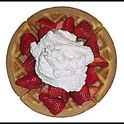Can I make homemade corn tortillas out of cornmeal instead of masa? Or is there a way to turn cornmeal into masa?
4 Comments
pierinoOctober 3, 2012
And a brief historical note, speaking to ChefOno's point; corn is a New World crop. When it arrived in Europe they didn't understand the nixtamalization part (the native Americans already had that down) so the way it was used wasn't providing nutrition as a staple. The Italians finally figured it out (polenta) but in France corn is mainly grown to feed to pigs.
ChefOnoOctober 3, 2012
Small correction: Hominy is the result of nixtamalization of corn. The alkali treatment not only softens the kernels, it breaks down some of the oil into emulsifiers and contributes calcium which acts as a binding agent. Simple ground corn, lacking those properties, won't form the type of dough necessary for a thin tortilla.
Incidentally, the emulsifiers are mono- and diglycerides, "chemicals" you often see on ingredient labels. Also note that hominy and masa are two of the original "processed" foods, much more useful and nutritious than "natural" corn.
The second question is somewhat interesting but I don't think I'd try it. Washing whole corn kernels of excess lime is one thing, I suspect removing it from corn meal could be an entirely different matter.
A Whole Foods Market CustomerOctober 3, 2012
Of note, nixtamalization also releases certain nutrients that are not biologically available in the natural hominy corn.
HalfPintOctober 2, 2012
No, masa is hominy corn which has been treated and processed with slake lime in a process called nixtamalization. The processing in the lime basically softens the corn so that you can make the tortillas or masa harina. I don't think you can successfully turn cornmeal into masa just because the cornmeal has not undergone the nixtamalization.
Showing 4 out of 4 Comments
Recommended by Food52
Popular on Food52
Continue After Advertisement





